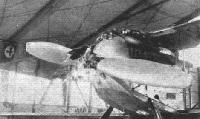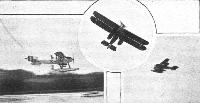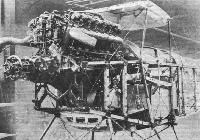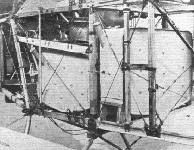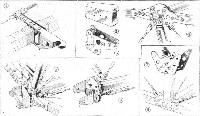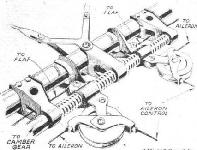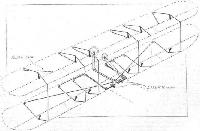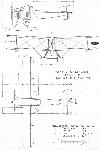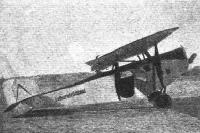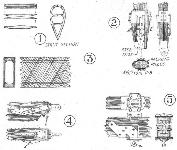Фотографии
-
THE FAIREY TYPE IIID SEAPLANE: Our photograph shows the "A.N.A.2," the second machine to be finished for the Australian Naval Air Service. Except for minor alterations this machine is similar to the standard type IIID described herewith.
Самолёты на фотографии: Fairey Fairey III - Великобритания - 1917
-
CHRISTENING THE FAIREY IIID-ROLLS: At the moment of the breaking of the bottle of champagne on the propeller boss, by Mrs. A. M. Hughes, wife of the Australian Premier.
Самолёты на фотографии: Fairey Fairey III - Великобритания - 1917
-
ON THE SLIPWAY: The Fairey "A.N.A.1" shortly before the launching.
Самолёты на фотографии: Fairey Fairey III - Великобритания - 1917
-
THE FAIREY TYPE IIID SEAPLANE: View of the engine plates.
Самолёты на фотографии: Fairey Fairey III - Великобритания - 1917
-
THE FAIREY "A.N.A.1": The machine being launched from its slipway.
Самолёты на фотографии: Fairey Fairey III - Великобритания - 1917
-
THE FAIREY "A.N.A.1": Three views of the machine in flight, carrying as passengers General Seely and General Sir Sefton Brancker.
Самолёты на фотографии: Fairey Fairey III - Великобритания - 1917
-
The Fairey Type IIID Seaplane: Front portion of the fuselage, showing Rolls-Royce "Eagle" engine.
Самолёты на фотографии: Fairey Fairey III - Великобритания - 1917
-
The Fairey IIID Seaplane: Photograph of an aileron, showing triangulated construction.
Самолёты на фотографии: Fairey Fairey III - Великобритания - 1917
-
The Fairey IIID Seaplane: Photograph of the tubular framework carrying lower spar attachments and worm-operating gear for flap control.
Самолёты на фотографии: Fairey Fairey III - Великобритания - 1917
-
The large petrol tanks of the Fairey IIID Seaplane.
Самолёты на фотографии: Fairey Fairey III - Великобритания - 1917
-
SOME CONSTRUCTIONAL DETAILS OF THE FAIREY TYPE IIID SEAPLANE: (1) The locking device which keeps the wings in place when folded. This fitting is mounted on the lower longeron of the fuselage. (2 and 3) The metal shoes on the ends of the longerons, where they are attached to the steel spool. (4) The spool joint in the top longeron, at the point where the engine unit joins the main fuselage. (5) The very ingenious steel spool at a point where about 14 members meet. (6) The steel spool without the fuselage members. (7) A typical fuselage fitting. (8) Fitting in place.
Самолёты на фотографии: Fairey Fairey III - Великобритания - 1917
-
The worm gear operating the wing flaps on the Fairey seaplanes.
Самолёты на фотографии: Fairey Fairey III - Великобритания - 1917
-
SOME WING DETAILS OF THE FAIREY TYPE HID SEAPLANE: (1) Details of the aileron crank, showing how welded joints are not relied upon to transmit stresses. (2) An aileron crank lever in place. (3) Section of a compression strut. The two halves are sprung together, the resulting strut being extremely strong. (4) An interplane strut fitting. The struts are steel tubes with wood fairings. (5) Attachment of built-up compression strut to wing spars. The strut end is located laterally by small wood wedges driven down in corners of U-bolt. (6) Attachment of nose rib to front spar. (7 and 8) Attachment of tubular trailing edge to wing ribs. (9 and 10) Details of the construction of the triangulated ailerons.
Самолёты на фотографии: Fairey Fairey III - Великобритания - 1917
-
Diagrammatic sketch of Fairey camber gear.
Самолёты на фотографии: Fairey Fairey III - Великобритания - 1917
-
Fairey Seaplane Type 3D 360 H.P. R.R.Eagle VIII
Самолёты на фотографии: Fairey Fairey III - Великобритания - 1917
-
THE SAB. P.3: Side view.
Самолёты на фотографии: Sablatnig P.III - Германия - 1919
-
The Sab. P.3: Three-quarter front view.
Самолёты на фотографии: Sablatnig P.III - Германия - 1919
-
THE SAB. P.3: Folding the wings. Note the tail plane folded upwards.
Самолёты на фотографии: Sablatnig P.III - Германия - 1919
-
The Sab. P.3: Front and rear views of the machine with wings folded. In the rear view can be seen the tubular pyramid which supports the wings from the sides of the fuselage.
Самолёты на фотографии: Sablatnig P.III - Германия - 1919
-
The Sab. P.3: Getting off.
Самолёты на фотографии: Sablatnig P.III - Германия - 1919
-
THE SAB. P.3: On left, carrying out the skis to the machine. Note the attachments, which fit on to the usual wheel axle. On right, the machine fitted with skis for use on snow.
Самолёты на фотографии: Sablatnig P.III - Германия - 1919
-
THE SAB. P.3: On left, putting up the tent which is carried on board; and, on right, the machine in its tent. Note the door and windows.
Самолёты на фотографии: Sablatnig P.III - Германия - 1919
-
THE SAB. P.3: Some wing details. 1. Diagram showing method of building-up a wing strut, and section of the latter. 2. The unusual fitting on the ends of the wing struts. 3. Diagram of spar construction. 4. End fitting on centre-section spar. 5. Swivel lug attachment of lift struts to main spars.
Самолёты на фотографии: Sablatnig P.III - Германия - 1919
-
THE SAB. P.3: Some details of the fuselage construction, etc. 1. Diagrammatic side and plan views of the fuselage, showing accommodation, etc. 2. Diagram of manner in which landing-shocks are transmitted to, and distributed over, the fuselage framework. 3. Lug attachment on lower longeron for wing strut. Note the three long tie-rods running right across the fuselage. 4. Detail of corner brackets in fuselage. 5. Chassis strut fitting on lower longeron. 6. Attachment of centre-section struts to top longeron. 7. One of the formers of the fin, built into the fuselage.
Самолёты на фотографии: Sablatnig P.III - Германия - 1919
-
DOMINION PREMIERS INSPECT "AMPHIBIAN": There is little doubt that in the Colonies and Dominions, no less than at home, the amphibian type of aircraft has an enormous future before it. It was therefore very fitting that on their recent visit to Waddon the Dominion Premiers should have an opportunity of inspecting the Vickers "Viking III," 450 h.p. Napier Lion, which won First Prize in the Government competition last year, and which has since done such good work in demonstrating the possibility of using the Thames and Seine rivers as "aerodromes." In the photograph Capt. Cockerell, the well-known Vickers pilot, is seen in front of the machine, in conversation with Sir P. Sykes and Capt. Guest, Secretary of State for Air.
Самолёты на фотографии: Vickers Viking / Type 54 - Великобритания - 1919
-
The Avro "Baby" seaplane, fitted with an 80 h.p Le Rhone, one which has been supplied to Sir Ernest Shackleton for his Antarctic expedition.
Самолёты на фотографии: Avro Antarctic Baby / Type 554 - Великобритания - 1921
-
THE AVRO BABY SEAPLANE: Three-quarter rear view.
Самолёты на фотографии: Avro Antarctic Baby / Type 554 - Великобритания - 1921
-
Avro Baby Seaplane 80 HP Le Rhone Engine
Самолёты на фотографии: Avro Antarctic Baby / Type 554 - Великобритания - 1921
Статьи
- Flight

